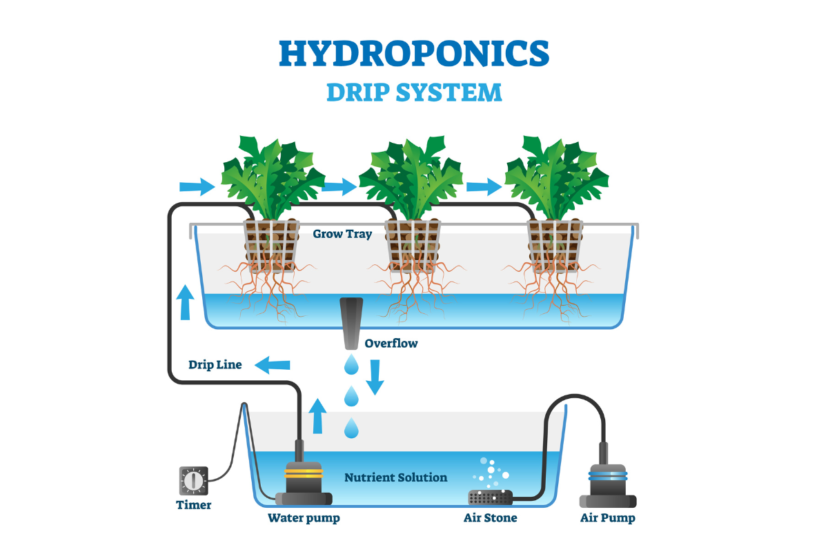Hydroponic Drip System: Navigating the Highs and Lows
Let’s talk about the intricacies of a hydroponic drip system. This method, though complex, offers a sustainable and efficient way to cultivate plants. It’s a journey of learning and adaptation, filled with rewarding challenges and substantial benefits.
Understanding Hydroponic Drip Systems
At its core, a hydroponic drip system is a method of delivering water and nutrients directly to the roots of plants, without soil. This system typically includes a timer, a reservoir, a pump, delivery tubes, and drip emitters. It’s like setting up a life-support system for your plants, where every nutrient is precisely delivered.
Benefits of Hydroponic Drip Systems
- Water and Nutrient Efficiency: This system is a champion of conservation, reducing water and nutrient wastage significantly.
- Space Maximization: Ideal for limited spaces, it allows for vertical and dense plant arrangements.
- Improved Plant Growth: The direct nutrient delivery accelerates growth and improves yield.
- Reduced Pest and Disease Risk: With no soil, the risk of soil-borne diseases and pests diminishes.
Challenges in Hydroponic Drip Systems
- System Complexity: It’s not a set-and-forget system. You need to understand the nuances and respond accordingly.
- Water and Nutrient Management: Balancing the pH, electrical conductivity (EC), and nutrient levels can be tricky.
- Initial Setup Cost: The upfront investment can be significant, especially for larger or more advanced systems.
- Maintenance Requirements: Regular checks and maintenance are crucial for system efficiency and plant health.
Setting Up a Basic Hydroponic Drip System
I’ll guide you through setting up a basic system. You’ll need a reservoir, a pump, tubing, drip emitters, a timer, and a growing medium. The process involves connecting the pump to the tubing, distributing it across your plant containers, and setting up the timer for automated watering.
Advanced Tips for Optimizing Your System
Customizing your nutrient solution based on plant needs can significantly boost growth.
Regularly monitoring the pH and EC levels ensures your plants are getting the right nutrients in the right quantities.
Common Mistakes to Avoid
Overwatering or under-watering can stress your plants. Finding that balance is key.
A clean system is a healthy system. Regular cleaning prevents clogs and disease.
The Role of Growing Mediums
Choosing the right growing medium, like coco coir, rock wool, or clay pellets, can impact root health and water retention. Each has its unique benefits and fits different plant types.
Managing the Environment
Temperature and humidity control are critical for plant health. Monitoring and adjusting these factors can lead to better growth.
Adequate lighting, especially in indoor setups, is crucial for photosynthesis and growth.
Future of Hydroponic Drip Systems
Technological advancements like automated sensors and AI-based monitoring are making these systems more accessible and efficient. The sustainability aspect, particularly in water conservation, is increasingly important in our changing climate.
Personal Experience and Recommendations
The key takeaway is patience and continuous learning. Start small, experiment, and don’t be afraid to make adjustments based on what your plants tell you. There are many hydroponic methods available to you. If you are having difficulty getting the results you want from one method, do some research and consider switching to a different method.
Conclusion
The hydroponic drip system is a fascinating and effective method of cultivation. While it comes with its set of challenges, the benefits, in terms of efficiency, yield, and environmental impact, are undeniable. I encourage anyone interested in hydroponics to explore this method.
FAQs
What is the best growing medium for a hydroponic drip system?
The ideal growing medium depends on the type of plants you’re growing and your system’s specifics. Common choices include coco coir, rock wool, and clay pellets. Coco coir is great for retaining moisture and offers good air space, rock wool is known for its excellent water retention and aeration properties, and clay pellets are ideal for systems that require good drainage and airflow. It’s important to choose a medium that supports your plant’s root system and works well with the drip setup.
How often should the nutrient solution be changed in a hydroponic drip system?
Typically, the nutrient solution in a hydroponic drip system should be changed every two to three weeks. This interval can vary based on the size of your reservoir, the number of plants, and their growth stage. Regular monitoring of the nutrient solution’s pH and electrical conductivity (EC) levels is crucial. If these levels fluctuate significantly, it may indicate the need for a solution change.
Can a hydroponic drip system be used for all types of plants?
Hydroponic drip systems are versatile and can support a wide range of plants, including vegetables, herbs, and flowers. They are particularly effective for plants that require consistent moisture and nutrient levels. However, it’s important to customize the system and nutrient delivery schedule based on the specific needs of the plants you are growing.
How do I troubleshoot common issues in my hydroponic drip system?
Common issues in hydroponic drip systems include clogged emitters, pH imbalances, and nutrient deficiencies or excesses. To troubleshoot, regularly check and clean your emitters to prevent clogging. Regularly test the pH and EC levels of your nutrient solution, adjusting as necessary. If plants show signs of nutrient deficiencies or excesses, review and adjust your nutrient solution formula. Also, ensure that your system’s timer is set correctly for optimal watering intervals.
Is a hydroponic drip system suitable for beginners in hydroponics?
Hydroponic drip systems can be suitable for beginners, but they require a bit more attention and understanding compared to some simpler hydroponic methods. Beginners should start with a basic setup, learn about the specific requirements of their chosen plants, and be prepared to monitor and adjust their system regularly. With patience and a willingness to learn, beginners can successfully manage a hydroponic drip system.




